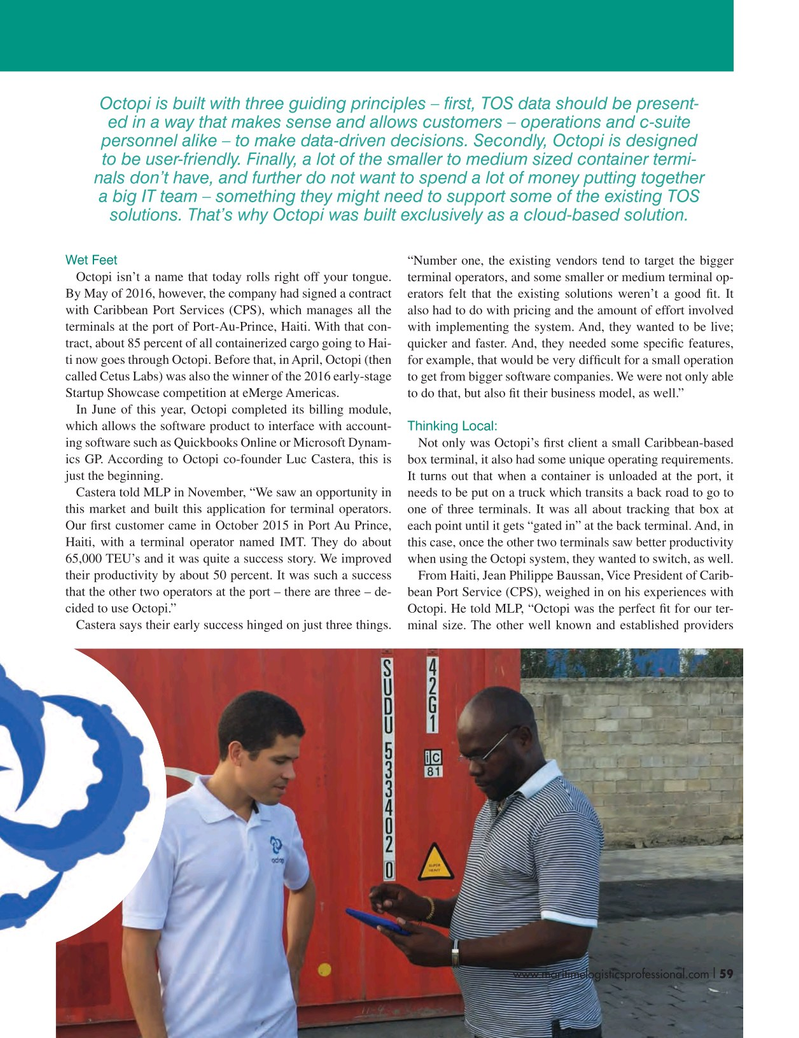
Page 59: of Maritime Logistics Professional Magazine (Q4 2016)
Workboats
Read this page in Pdf, Flash or Html5 edition of Q4 2016 Maritime Logistics Professional Magazine
Octopi is built with three guiding principles – ? rst, TOS data should be present- ed in a way that makes sense and allows customers – operations and c-suite personnel alike – to make data-driven decisions. Secondly, Octopi is designed to be user-friendly. Finally, a lot of the smaller to medium sized container termi- nals don’t have, and further do not want to spend a lot of money putting together a big IT team – something they might need to support some of the existing TOS solutions. That’s why Octopi was built exclusively as a cloud-based solution.
Wet Feet “Number one, the existing vendors tend to target the bigger
Octopi isn’t a name that today rolls right off your tongue. terminal operators, and some smaller or medium terminal op-
By May of 2016, however, the company had signed a contract erators felt that the existing solutions weren’t a good ? t. It with Caribbean Port Services (CPS), which manages all the also had to do with pricing and the amount of effort involved terminals at the port of Port-Au-Prince, Haiti. With that con- with implementing the system. And, they wanted to be live; tract, about 85 percent of all containerized cargo going to Hai- quicker and faster. And, they needed some speci? c features, ti now goes through Octopi. Before that, in April, Octopi (then for example, that would be very dif? cult for a small operation called Cetus Labs) was also the winner of the 2016 early-stage to get from bigger software companies. We were not only able
Startup Showcase competition at eMerge Americas. to do that, but also ? t their business model, as well.”
In June of this year, Octopi completed its billing module, which allows the software product to interface with account- Thinking Local: ing software such as Quickbooks Online or Microsoft Dynam- Not only was Octopi’s ? rst client a small Caribbean-based ics GP. According to Octopi co-founder Luc Castera, this is box terminal, it also had some unique operating requirements. just the beginning. It turns out that when a container is unloaded at the port, it
Castera told MLP in November, “We saw an opportunity in needs to be put on a truck which transits a back road to go to this market and built this application for terminal operators. one of three terminals. It was all about tracking that box at
Our ? rst customer came in October 2015 in Port Au Prince, each point until it gets “gated in” at the back terminal. And, in
Haiti, with a terminal operator named IMT. They do about this case, once the other two terminals saw better productivity 65,000 TEU’s and it was quite a success story. We improved when using the Octopi system, they wanted to switch, as well.
their productivity by about 50 percent. It was such a success From Haiti, Jean Philippe Baussan, Vice President of Carib- that the other two operators at the port – there are three – de- bean Port Service (CPS), weighed in on his experiences with cided to use Octopi.” Octopi. He told MLP, “Octopi was the perfect ? t for our ter-
Castera says their early success hinged on just three things. minal size. The other well known and established providers www.maritimelogisticsprofessional.com 59I 50-63 Q4 MP2016.indd 59 11/9/2016 11:39:22 AM

 58
58

 60
60
